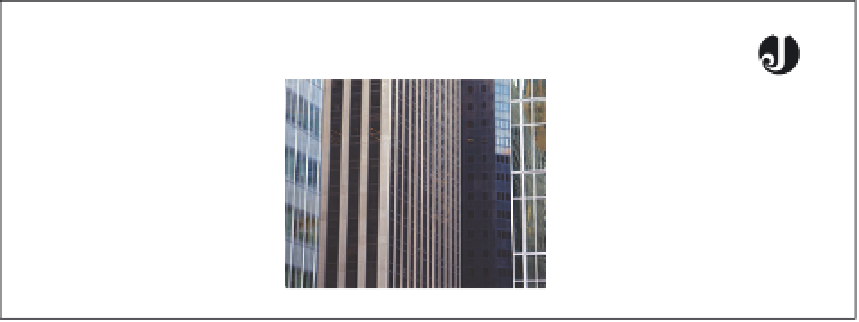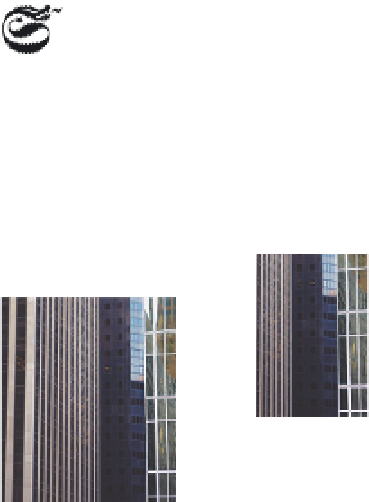Graphics Reference
In-Depth Information
Grids may consist of primary and
secondary divisions of space. For example, the
grid used in this book consists of two columns
as the dominant structure, with an optional
structure of six columns (note the visible grid
lines on this page). Concurrent grids not only
provide added flexibility, they also enable
the designer to layer typographic elements,
achieving the illusion of three-dimensional
space (Figs.
4-21
and
4-22
).
Experimentation with multicolumn
grids can yield visually surprising and
functional results. Columns can be
shifted horizontally and vertically, placed
at opposing angles, or behave in ways
extending typographic tradition. However,
such effects should only be used when they
contribute to the interpretation of the text
(Figs.
4-23 to 4-26
).
Typographic Design:
Form and Communication
A grid is a skeletal framework used by designers
to organize, relate, and control content within
a spatial field. It is a system characterized by the
dualities of freedom and constraint, simplicity
and complexity.
Typographic Design:
Form and Communication
A grid is a skeletal
framework used by
designers to organize,
relate, and control
content within a spatial
field. It is a system
characterized by the
dualities of freedom
and constraint,
simplicity and
complexity.
The whole duty of typography, as
with calligraphy, is to communicate
to the imagination, without loss
by the way, the thought or image
intended to be communicated by
the author. And the whole duty
of beautiful typography is not to
substitute for the beauty or interest
of the thing thought and intended
to be conveyed by the symbol, a
beauty or interest of its own, but, on
the one hand, to win access for that
communication by the clearness
and beauty of the vehicle, and on
the other hand, to take advantage
of every pause or stage in that
communication to interpose some
characteristic & restful beauty in
its own art. We thus have a reason
for the clearness and beauty of the
first and introductory page and
of the title, and for the especial
beauty of the headings of chapters,
capital or initial letters, and so on,
and an opening for the illustrator
as we shall see by and by.The
whole duty of typography, as with
calligraphy, is to communicate to
the imagination, without loss by the
way, the thought or image intended
to be communicated by the author.
And the whole duty of beautiful
typography is not to substitute
for the beauty or interest of the
thing thought and intended to be
conveyed by the symbol, a beauty
or interest of its own, but, on the
one hand, to win access for that
communication by the clearness
and beauty of the vehicle, and on
the other hand, to take advantage
of every pause or stage in that
communication to interpose some
characteristic & restful beauty in
its own art. We thus have a reason
for the clearness and beauty of
the first and introductory page.
The whole duty of typography, as
with calligraphy, is to communicate
to the imagination, without loss
by the way, the thought or image
intended to be communicated by
the author. And the whole duty
of beautiful typography is not to
substitute for the beauty or interest
of the thing thought and intended
to be conveyed by the symbol, a
beauty or interest of its own, but, on
the one hand, to win access for that
communication by the clearness
and beauty of the vehicle, and on
the other hand, to take advantage
of every pause or stage in that
communication to interpose some
characteristic & restful beauty in
its own art. We thus have a reason
for the clearness and beauty of the
first and introductory page and
of the title, and for the especial
beauty of the headings of chapters,
capital or initial letters, and so on,
and an opening for the illustrator
as we shall see by and by.The
whole duty of typography, as with
calligraphy,
is to communicate to the
imagination, without loss by
the way, the thought or image
intended to be communicated
by the author.
And the whole duty of beautiful typography is not to substitute for the
beauty or interest of the thing thought and intended to be conveyed by
the symbol, a beauty or interest of its own, but, on the one hand, to win
access for that communication by the clearness and beauty of the vehicle,
and on the other hand, to take advantage of every pause or stage in that
communication to interpose some characteristic & restful beauty in its
own art. We thus have a reason for the clearness and beauty of the first
and introductory page and of the title, and for the especial beauty of the
headings of chapters, capital or initial letters, and so on, and an opening for
the illustrator as we shall see by and by.The whole duty of typography,
as with calligraphy, is to communicate to the imagination, without loss by
the way, the thought or image intended to be communicated by the author.
A grid is a skeletal framework used by designers
to organize, relate, and control content within
a spatial field. It is a system characterized by the
dualities of freedom and constraint, simplicity
and complexity.
A grid is a skeletal framework used by designers
to organize, relate, and control content within
a spatial field. It is a system characterized by the
dualities of freedom and constraint, simplicity
and complexity.
4-21
Concurrent grids and multicolumn grids with irregular column intervals can
be used to accommodate information needing special treatment. Specific types of
information can inhabit assigned columnar zones to preserve their autonomy. In
the example shown, the far right column is reserved for the display of alphabetic
characters.
Typographic Design:
Form and Communication
A grid is a skeletal framework used by
designers to organize, relate, and control
content within a spatial field. It is a
system characterized by the dualities
of freedom and constraint, simplicity
and complexity.
A grid is a skeletal framework used by
designers to organize, relate, and control
content within a spatial field. It is a
system characterized by the dualities
of freedom and constraint, simplicity
and complexity.
The whole duty of typography, as
with calligraphy, is to communicate
to the imagination, without loss
by the way, the thought or image
intended to be communicated by
the author. And the whole duty
of beautiful typography is not to
substitute for the beauty or interest
of the thing thought and intended
to be conveyed by the symbol, a
beauty or interest of its own, but,
on the one hand, to win access
for that communication by the
clearness and beauty of the vehicle,
and on the other hand, to take
advantage of every pause or stage
in that communication to interpose
some characteristic & restful beauty
in its own art. We thus have a
reason for the clearness and beauty
of the first and introductory page
and of the title, and for the especial
beauty of the headings of chapters,
capital or initial letters, and so on,
and an opening for the illustrator
as we shall see by and by.The
whole duty of typography, as with
calligraphy, is to communicate
to the imagination, without loss
by the way, the thought or image
intended to be communicated by
the author. And the whole duty
of beautiful typography is not
to substitute for the beauty or
interest of the thing thought and
intended to be conveyed by the
symbol, a beauty or interest of its
own, but, on the one hand, to win
access for that communication by
the clearness and beauty of the
vehicle, and on the other hand, to
take advantage of every pause or
stage in that communication to
interpose some characteristic &
restful beauty in its own art. We thus
have a reason for the clearness and
beauty of the first and introductory
page and of the title, and for the
especial beauty of the headings of
chapters, capital or initial letters,
and so on, and an opening for the
illustrator as we shall see by and by.
The whole duty of typography, as
with calligraphy, is to communicate
to the imagination, without loss
by the way, the thought or image
intended to be communicated by
the author. And the whole duty
of beautiful typography is not to
substitute for the beauty or interest
of the thing thought and intended
to be conveyed by the symbol, a
beauty or interest of its own, but, on
the one hand, to win access for that
communication by the clearness
and beauty of the vehicle, and on
the other hand, to take advantage
of every pause or stage in that
communication to interpose some
characteristic & restful beauty in its
own art. We thus have a reason for
the clearness and beauty of the first
and introductory page and of the
title, and for the especial beauty of
the headings of chapters, capital
or initial letters, and so on, and an
opening for the illustrator as we
shall see by and by.The whole duty
of typography, as with calligraphy,
is to communicate to the
imagination, without loss by the
way, the thought or image intended
to be communicated by the author.
And the whole duty of beautiful
typography is not to substitute
for the beauty or interest of the
thing thought and intended to be
conveyed by the symbol, a beauty
or interest of its own, but, on the
one hand, to win access for that
communication by the clearness
and beauty of the vehicle, and on
the other hand, to take advantage
of every pause or stage in that
communication to interpose some
characteristic & restful beauty in
its own art. We thus have a reason
for the clearness and beauty of the
first and introductory page and
of the title, and for the especial
beauty of the headings of chapters,
capital or initial letters, and so on,
and an opening for the illustrator
as we shall see by and by.The
whole duty of typography, as with
calligraphy, is to communicate to
the imagination, without loss by the
way, the thought or image intended
to be communicated by the author.
And the whole duty of beautiful
typography is not to substitute
for the beauty or interest of the
thing thought and intended to be
conveyed by the symbol, a beauty
or interest of its own, but, on the
one hand, to win access for that
communication by the clearness
and beauty of the vehicle, and on
the other hand, to take advantage
of every pause or stage in that
communication to interpose some
characteristic & restful beauty in
its own art. We thus have a reason
for the clearness and beauty of the
first and introductory page and
of the title, and for the especial
beauty of the headings of chapters,
capital or initial letters, and so on,
and an opening for the illustrator
as we shall see by and by.The
whole duty of typography, as with
calligraphy, is to communicate
to the imagination, without loss
by the way, the thought or image
intended to be communicated by
the author. And the whole duty
of beautiful typography is not
to substitute for the beauty or
interest of the thing thought and
intended to be conveyed by the
symbol, a beauty or interest of its
own, but, on the one hand, to win
access for that communication by
the clearness and beauty of the
vehicle, and on the other hand, to
take advantage of every pause or
stage in that communication to
interpose some characteristic &
restful beauty in its own art. We thus
have a reason for the clearness and
beauty of the first and introductory
page and of the title, and for the
especial beauty of the headings of
chapters, capital or initial letters,
and so on, and an opening for the
illustrator as we shall see by and by.
The whole duty of typography, as
with calligraphy, is to communicate
to the imagination, without loss
by the way, the thought or image
intended to be communicated by
the author. And the whole duty
of beautiful typography is not to
substitute for the beauty or interest
of the thing thought and intended
to be conveyed by the symbol, a
beauty or interest of its own, but, on
the one hand, to win access for that
communication by the clearness
and beauty of the vehicle, and on
the other hand, to take advantage
of every pause or stage in that
communication to interpose some
characteristic & restful beauty in
its own art. We thus have a reason
for the clearness and beauty of the
first and introductory page and
of the title, and for the especial
beauty of the headings of chapters,
capital or initial letters, and so on,
and an opening for the illustrator
as we shall see by and by.The
whole duty of typography, as with
calligraphy, is to communicate to
the imagination, without loss by the
way, the thought or image intended
to be communicated by the author.
And the whole duty of beautiful
typography is not to substitute
for the beauty or interest of the
thing thought and intended to be
conveyed by the symbol, a beauty
or interest of its own, but, on the
one hand, to win access for that
communication by the clearness
and beauty of the vehicle, and on
the other hand, to take advantage
of every pause or stage in that
communication to interpose some
characteristic & restful beauty in its
own art. We thus have a reason for
the clearness and beauty of the first
and introductory page and of the
title, and for the especial beauty of
the headings of chapters, capital
4-22
Multicolumn grids can be applied to many different situations, as in this
format consisting of three panels, each divided into three columns.


































































